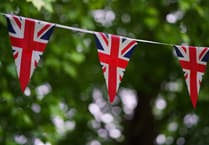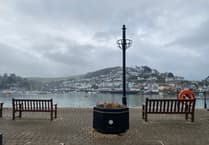ESSENTIAL repairs are being carried out on the refloated French trawler before she can be towed away from Dartmouth.
The work is expected to completed by next week.
A salvage vessel lifted the capsized St Christophe I that had been partially submerged for more than three weeks in Dartmouth harbour.
Five fishermen had to be rescued in the early hours of Thursday, March 10, when it capsized after seeking shelter from rough seas.
Last Saturday, the 55m Dutch work barge, Sea Devil, and crane successfully lifted and refloated the stricken boat.
Harbour master Rob Giles said: ‘Dart Harbour still awaits a forward plan for the St Christophe I from the insurers. Possibilities include the vessel is declared a total loss and is disposed of; the vessel could be repatriated under tow; or it could be sold to a new owner.
‘The vessel is now undergoing essential seaworthy repairs that are expected to take around three or four days to complete before the vessel can be towed away from Dartmouth.’
Representatives from the Dutch salvage company, Multraship, arrived in Dartmouth last Wednesday and the barge made an impressive sight as she arrived in the port the following evening.
Capt Giles said: ‘Following the arrival of the salvage team from Multraship, appointed by the St Christophe I insurers, the salvage barge was moved into position and successfully raised the St Christophe I to the surface last Saturday, using their 140 tonne capacity crane.
‘With the vessel having spent several days resting on the river bed, divers were required to air lance under the vessel in order that the slings that would be used for the lift could be put around the hull.
‘The lifting operation began around 5pm Saturday and took about 30 minutes to raise the Saint Christophe I to the surface using a 140 tonne capacity crane and watched by a crowd of cheering onlookers.
‘The lift was very successful with no fuel escaping from the vessel during the process.
‘To that end the pollution control aspects put in place by DHNA have been proved to be very effective.
’In addition, as a testament to this, the 1.5 tonnes of fish that were onboard the vessel when she capsized have been devoured by wildlife – seals, crabs and I am informed by the divers, a resident conger eel.
‘It’s clear that the river’s flora and fauna have not been adversely affected in any way by pollution, instead they have thrived. Make sure you check the breaking strain of your crabbing lines this summer.’
Capt Giles said the vessel currently remained in the crane slings, as this was the safest place for it.
‘There are some essential watertight integrity issues that need addressing before the vessel can be released,’ he said.
‘Now the vessel is upright, there is virtually no pollution risk, so Dart Harbour will be scaling down its pollution control effort with a view to ending this part of the project.
‘Once this takes place, it will remove the need for the cordon on the South Embankment so the area can be returned to its normal use.
‘As usual, the vast majority of the people of Dartmouth have been understanding of the situation and I wish to express my sincere gratitude to these people.
‘I would also like to pay tribute to the Dart Harbour staff involved for their professional handling of the situation and their willingness to work additional shifts to ensure the situation remained stable.
‘While we always hope incidents such as this will not happen, Dart Harbour has detailed plans in place for dealing with such circumstances which, in this case, have proved very effective.
‘I hope the incident hasn’t put the crew off Dartmouth and they will visit us again under better circumstances.’





Comments
This article has no comments yet. Be the first to leave a comment.